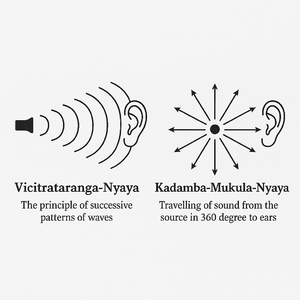Gunas in Nyaya Shastra (न्यायशास्त्रानुसारेण गुणनिरुपणम्)
"Among the seven fundamental categories (padarthas) (पदार्थाः) discussed in Nyayashastra, guna holds a significant position in explaining the qualities that reside in substances and shape our experience of the world. In this article, we explore guna as presented in Nyayashastra, covering its definition, classifications, and essential traits from works such as Tarkasamgraha and Nyayasiddhantamuktavali."
परिचयः ॥ Introduction
In this article, the word Nyaya-Shastra is used to refer to both Nyaya and vaisheshika darshanas combined. Although Nyaya and vaisheshika are two different darshanas, or schools of philosophy, they are traditionally studied together under the common title Nyaya-Shastra. Wherein the classification and nature of padartha (elements) are discussed as per vaisheshika darshana, and the classification and nature of pramana (means of valid source of knowledge) are discussed as per the nyaya darshana.
As per the Nyaya-Shastra, the valid knowledge of the seven padarthas leads a person to moksha or final emancipation from the cycle of life and death.
धर्मविशेषप्रसूताद् द्रव्यगुणकर्मसामान्यविशेषसमवायानां पदार्थानां साधर्म्यवैधर्म्याभ्यां तत्त्वज्ञानान्निःश्रेयसम् | dharmmaviśeṣaprasūtād dravyaguṇakarmasāmānyaviśeṣasamavāyānāṃ padārthanāṃ sādharmyavaidharmyābhyāṃ tattvajñānānniḥśreyasam
The seven padarthas are dravya (substance), guna (Quality,) karma (Action), samanya (Generality,) vishesha (particularity), samavaya (inherence) and abhava (non-existence). Understanding these categories, along with their similarities and differences, leads to niḥśreyas or highest good.
In this article, we will discuss guna, including its definition according to Nyaya-shastra, its types, subtypes, and other important characteristics as described in introductory texts such as Tarkasangraha and Nyayasiddhantamuktavali.
लक्षणम् ॥ Definition
Guna is defined in tarkasangraha as follows:
द्रव्यकर्मभिन्नत्वे सति सामान्यवान् गुणः | dravyakarmabhinnatve sati sāmānyavān guṇaḥ
The aforementioned definition is composed of two segments: dravyakarmabhinnatvam and samanyavattvam
- dravyakarmabhinnatvam is a segment which differentiates guṇa from dravya and karma. dravya, guna and karma all three are padarthas, and also possess samanya. Due to these similarities, if guna is just defined as samanyavaan, the definition may also apply to dravya and karma resulting in its fallacy called over-application or ativyapti. Thus, the segment dravyakarmabhinnatvam differentiates guna from dravya and karma.
- Samanyavattvam refers to characteristics of possessing samanya or generality. As per the nyaya-shastra, dravya, guna and karma are the elements which possess samanya. So, samanyavattvam is a distinguishing quality of these three elements. If one attempts to define guna with just one segment i.e dravyakarmabhinnatvam, then the definition may apply to all other four padartha which are not guna, but are different from dravya and karma. This again leads to the aforementioned fallacy of over-application or ativyapti. By adding this segment, guna is properly distinguished from the other four padarthas, resulting in effective avoidance of the definitional fallacy.
In brief, guṇa is a padārtha that possesses sāmānya and is different from dravya and karma.
Nyāyasiddhāntamuktāvalī, one of the elementary texts of Nyāyaśāstra states:
अथ द्रव्याश्रिता ज्ञेया निर्गुणा निष्क्रिया गुणाः | atha dravyāśritā jñeyā nirguṇā niṣkriyā guṇāḥ
This implies that guṇas inherently abide in dravya and do not exist independently. Also, neither a guna nor a karma exists within a guna.
We will discuss a detailed classification of these gunas in the next section and discuss how each of these guṇas exists within one or more dravya.
विभागः ॥ Classification
In nyāyaśāstra, these guṇas are said to be twenty-four in number. Tarkasaṃgraha, one of the elementary texts of nyāyaśāstra, states:
रुपरसगन्धस्पर्शसङ्ख्यापरिमाणपृथक्त्वसंयोगविभागपरत्वापरत्वगुरुत्वद्रवत्वस्नेहशब्दबुद्धिसुखदुःखेच्छाद्वेषप्रयत्नधर्माधर्मसंस्काराश्चतुर्विंशति गुणाः
ruparasagandhasparśasaṃkhyāparimāṇapṛthaktvasaṃyogavibhāgaparatvāparatvagurutvadravatvasnehaśabdabuddhisukhaduḥkhecchādveṣaprayatnadharmādharmasaṃskārāścaturviṃśati guṇāḥ.
i.e. rupa (colour) rasa (taste), gandha (odour), sparsha (touch), samkhya (number), parimaanam (Measurment), prithaktva (seperateness), samyoga (conjunction), vibhaga (disjunction), paratva (greatness) aparatva (littleness) Gurutva (Heaviness) dravatva (fluidity), sneha (viscidity), shabda (sound), buddhi (knowledge), sukha (pleasure), dukha (pain), ichcha (desire), devsha (aversion), prayatna (effort), dharma (merit), adharma (demerit) and samskara (impression) are twenty-four qualities or gunas.
Rupa (रुपम्)
Rupa or colour is first among gunas. The guna, which is exclusively apprehended by chakshurindriya or eye, is rupa. It is further classified into seven categories - shukla (white), neela (blue), peeta (yellow), rakta (red), harita (green), kapeesha (tawny) and chitra (variegated).
The Rupam resides on three dravyas - prithvi (earth), jalam (water), tejas (fire).
| Dravya | Prithvi | Jalam | Tejas |
|---|---|---|---|
| Types of Rupa (colour) present | All seven colours | Abhaasvarshukla
(Non-brilliant white) |
Bhaasvarahukla
(Brilliant white) |
Rasa (रसः)
Rasa or taste is a guna which is apprehended by rasanendriya, which is present on tip of tongue. It is further categorized into six distinct classifications. They are - madhura (sweet, as in sugar), aamla(sour, as in lemon), lavana (salty), katu (pungent, as in chilli), kashaya (astringent, as in āṃvalā), tikta (bitter, as in bittergourd).
| Dravya | Prithvi | Jalam |
|---|---|---|
| Types of Rasa (taste) present | All six tastes | Madhura
(sweet) |
Gandha (गन्धः)
Gandha or odour is a guṇa which is perceived by the ghranendriya. It is of two types - fragrant and non-fragrant. Both types are exclusively identified as the quality of earth.
Sparsha (स्पर्शः)
Sparsha or touch is a guna which is exclusively apprehended by tvagindriya, which is present all over the body. It is of three types, viz. Cold (sheeta), hot (ushna) and temperate (anushnashita). It is present in earth, water, fire and air.
| Dravya | prithvi | jalam | teja | vayu |
|---|---|---|---|---|
| Types of Sparsha (touch) present | Temperate
(anushnasheeta) |
Cold
(sheeta) |
Hot
(ushna) |
Temperate
(anushnasheeta) |
Samkhya (सङ्ख्या)
Samkhya or a number is an immediate cause for the usage of terms like one, two etc. It is present in all the nine dravyas and ranges from one to paraardha i.e. the highest number. Ekatvam or one is both eternal and non - eternal. While all the numbers from two are non-eternal, one when abided with eternal objects is eternal and when abided with non- eternal objects, is non- eternal.
Parimanam (परिमाणम्)
As stated by Annambhatta , parimanam can be defined as a particular cause for the usage of the terms regarding measurement of an object. This parimanam is of four types - anu (atomic), mahad (possessing magnitude), deergham (long), hrasvam (short). This, too, is present in all the nine dravyas.
Prithaktva (पृथक्त्वम्)
Prithaktva or separateness is a guna which is defined as a particular cause for stating the difference between two entities. It inheres in all the dravyas. For instance, when one asserts that one mango differs from another, it is due to the presence of prithaktva within each.
Samyoga (संयोगः)
Samyoga or conjunction is a particular reason, for the cause of usage of terms related to the conjoined substances. It inheres in all dravyas. It is of two types, karmaja samyoga (action-derived conjunction) and samyogaja samyoga (conjunction-derived conjunction). It is a avyāpyavṛtti guṇa (quality having non-pervaded occurrence or quality which co-exists with its absence)
| Karmaja samyoga (action-derived conjunction) | Samyogaja samyoga (conjunction-derived conjunction) |
|---|---|
| A conjunction (saṃyoga) that arises from an action (karma) is termed karmaja saṃyoga.
When we lift our phone and put it on the desk, the conjunction (saṃyoga) of phone and desk is due to our action (karma). |
A conjunction that results from another conjunction is known as saṃyogaja saṃyoga.
When one picks up the phone and puts it on top of the notebook that is already placed on the desk, the phone and the desk are in indirect contact with each other through the notebook. |
Vibhaga (विभागः)
Vibhaga or disjunction is the quality that breaks the conjunction. It inheres in all the nine dravyas. It is also categorised into two karmaja and vibhagaja .
When a pizza is cut into six pieces, the act of cutting creates a disjunction (vibhaga), breaking the natural conjunction (samyoga) that previously held the parts together. This is an example of karmaja vibhhaga, action-derived disjunction
When one withdraws one's hand out of the book, the act of pulling causes a disjunction (vibhaga). The very first disjunction leads to yet another disjunction by which the conjunction (samyoga) established between the book and the hand is disrupted. This is an example of vibhagaja vibhaga — disjunction - derived disjunction.
Paratvam - aparatvam (परत्वापरत्वे)
Paratvam - aparatvam (greatness and littleness) are the particular cause for the usage of the terms related to being great or little. It inheres in earth, water, fire, air and mind. It is of two types, one is with respect to space and another is with respect to time. The objects which are situated at a far and near possess greatness and littleness with respect to space respectively. A person who is senior (in age) and junior (in age) possesses greatness and littleness with respect to time respectively.
Gurutvam (गुरुत्वम्)
Gurutvam is the non - inherent cause for the first fall of an object. It inheres in earth and water. The non- inherent reason for the second and consequent falls is vega (velocity). When the mango falls to the ground its fall is initiated by gurutvam but later continued by vega. In other words, the first fall is caused by a while the subsequent continuation of falls is due to vega (velocity).
Dravatvam (द्रवत्वम्)
Dravatvam is the non - inherent cause for the first flow of an object. It inheres in earth, water, fire and air. It is of two types natural
(samsiddhikam) and artificial (naimittikam).
Natural fluidity is found in water whereas artificial fluidity is found in earth and fire. For example - a natural resin is an earthy substance obtained from a plant which generally is semi- solid in nature. When it is exposed to temperature, it becomes fluid. Such fluidity or dravatvam shown by earthy substances upon beng influenced by external factors is called as an artificial fluidity ornaimittikam dravatvam
Sneha (स्नेहः)
Sneha is a quality found in water. When any substance comes into contact with water, the sneha in the water causes pindibhava. It is a unique conjunction among the fine particles of that substance, leading to their cohesion and mutual attraction (as in wheat flour). If a liquid like milk, oil, or any other fluid shows the same effect, it is because of the watery component present in those liquids. In this way, sneha is a property that inherently belongs to water and thus wherever it is observed, it indicates the presence of water.
Shabda (शब्दः)
Shabda (sound) is a quality perceived by the shrotrendriya (the sense organ of hearing, i.e. the ears). it inherently exists only in akasha (space or ether). Shabda is classified into two types — inarticulate sound (dhvanyatmaka) and articulate sound (varnatmaka). Inarticulate sound refers to natural or non-verbal sounds, such as the sound of a bell, whereas all the languages are an example of articulate sound. Further, based on its origin, sound is categorized into three types:
- Samyogaja — Sound produced by the conjunction of two objects. For example, the sound produced when hands are clapped.
- Vibhagaja— Sound produced by the disjunction of two objects. For example, the cracking sound when a glass is broken into pieces.
- Shabdaja— Sound generated from a preceding sound. In this case, one sound gives rise to another similar sound, creating a chain of successive sounds.
As per the Nyayashastra (the Indian school of logic and epistemology), sound is described as trikshanaavasthaayi— it exists only for kshana i.e.one-fourth of a minute. In the first moment, it is generated; in the second, it remains momentarily and produces a similar sound; and in the third, it diminishes. Hence, the sound produced by preceding sound is called as Shabdaja Shabda (sound)
This process explains how sound travels through space.
The sound originates from the sound and propagates to our ears by producing successive sounds. veechitaranga-nyaya (the principle of successive wave patterns) and Kadamba-mukula-nyaya (travelling of sound from the source in 360 degree to ears). In this way, sound travels through space and is ultimately apprehended by the ears.
Buddhi (बुद्धिः)
In the Nyayashastra, the terms buddhi and jnana are used interchangeably to refer to knowledge. Knowledge is a quality which is cause of all vyavahara. Vyavahara refers to the usage of words which will produce or generate knowledge. (Dictionary of Nyaya Terms - V.N. Jha, 2001). It inherently resides in the atman. Knowledge is broadly classified into two types: Anubhava — (direct experience) and Smriti— remembrance (based on past experiences).
Anubhava is further divided into:
- Yathartha-anubhava — valid experience,
- Ayathartha-anubhava — invalid experience.
The valid experience (yathartha-anubhava) is categorized into four types:
- Pratyaksha— direct perception
- Anumiti — inference
- Upamiti — knowledge gained through comparison or analogy.
- Shabda — knowledge obtained from reliable verbal testimony.
The invalid experience (ayathartha-anubhava) is classified into three types:
- Samshaya— doubt or uncertainty.
- Tarka — hypothetical reasoning or supposition.
- Viparyaya — Invalid Cognition.
Sukham (सुखम्)
Why do we watch movies? Why do we want to go to a restaurant or have some delicious food? Why do some of us would like to go for an adventure or travel across the globe? There are so many such why’s in our day-to-day life - the answer to them is because by doing such things we get to experience sukham. Again the question - why do we want to experience sukham? This ‘why’ behind the wish to experience sukham remains unanswered, all other desires like we mentioned earlier are depended upon this desire to experience sukha. But the desire to experience the sukha is independent and a catalyst for all other desires. Thus, an object of a desire independent of any other desire can be termed as sukham.
Dukham (दुःखम्)
Why do we never want to fall ill? Why are we afraid of snakes or some insects? Why do we never want to get in any uncomfortable situations? The answer is because we don’t want to experience dukham. Our disinclination towards these things is due to our disinclination towards dukham. But, why we don’t want to experience dukham? This question continues to linger as the aforementioned disinclinations depend upon disinclination towards dukham, but the disinclination towards dukham is independent of all other disinclinations. Thus, an object of the disinclination independent of any other disinclination can be termed as dukham.
Ichcha (इच्छा)
Desire for the means of sukham arises from the experience of sukham (pleasure) through those means. For example, when a child tastes chocolate for the first time, it gives him an experience of pleasure. In order to relive that pleasure, the child desires the chocolate again — or seeks similar sources of sukham, such as ice-cream or other enjoyable treats.
Dvesha (द्वेषः)
Aversion arises from the experience of dukham (pain). For example, when we were young and a thorn pricked our hand, we experienced pain. To avoid experiencing that pain again, we develop an aversion to thorns or similar sources of pain such as sharp objects.
Prayatna (प्रयत्नः)
Prayatna is a quality possessing a generality pervaded by qualityness. It exists within the subject of the experiential knowledge which can be expressed as ‘I do’. It is of three types - pravritti yatna, nivritti yatna and jeevanyoni yatna.
Dharma/Punyam (धर्मः)
Dharma or punyam is a result of performing actions which are prescribed by the Vedas.
Adharma/Paapam(अधर्मः)
Adharma or paapam is a result of performing actions which are forbidden by Vedas.
Samskara (संस्कारः)
Samskara or impressions are of three types:
- Vega (Velocity): Velocity inheres in earth, water, fire, air, and mind.
- Bhavana (Mental Impressions): Bhavana, or mental impression, is generated by experiential knowledge and causes remembrance. It inheres in the atman only.
- Sthisthapaktva (Elasticity): Sthitisthapakam is an impression that restores the original form of an object whose form has been changed. It exists only in earthy substances like a rubber band.
प्रकाराः ॥ Categorization
All of these gunas can be further grouped in 16 categories. (Hariram Shukla Shastri, 2024)
- Murtaguna (मूर्तगुणाः)
- Amurtaguna (अमूर्तगुणाः)
- Murtaamurtaguna (मूर्तामूर्तगुणाः)
- Anekshratiguna (अनेकाश्रितगुणाः)
- Ekashritaguna (एकाश्रितगुणाः)
- Visheshaguna (विशेषगुणाः)
- Samanyaguna (सामान्यगुणाः)
- Dveendriyagrahyaguna (द्वीन्द्रियग्राह्यगुणाः)
- Ekendriyagrahyaguna (एकेन्द्रियग्राह्यगुणाः)
- Ateendriyaguna (अतीन्द्रियगुणाः)
- Akarangunotpannaguna (अकारणगुणोत्पन्नगुणाः)
- Karangunotpannaguna (कारणगुणोत्पन्नगुणाः)
- Karmajaguna (कर्मजगुणाः)
- Asamavaayiguna (असमवायिगुणाः)
- Nimittakaranguna (निमित्तकारणगुणाः)
- Dvividhakaranaguna (द्विविधकारणगुणाः)
| Murtagunas |
|---|
| Mūrtatvam is a characteristic of being a substratum of actions.
This is one of the characteristics inherent in some dravyas. Such dravyas are called mūrtadravyas.
|
| Amurtaguna |
|---|
| The gunas which reside in amurtadravya are called as murtagunas.
The dravyas which do not possess the characteristics of Mūrtatvam are called as amurtadravyas
|
| Murtaamurtaguna |
|---|
The gunas which reside both in mūrtadravyas and amūrtadravyas are called as Murtaamurtagunas.
|
| Anekashrita-guna |
|---|
The gunas which reside in more than one dravya are called as Anekashritagunas.
|
| Ekashritagunas |
|---|
The gunas which reside only in one dravya are called as Ekashritagunas
|
| Vishesha Gunas |
|---|
The gunas which are classified by nyayashastra as special are Visheshagunas
|
| Samanya- gunas |
|---|
The gunas other than Viśeṣaguṇas are called Samanyaguna.
|
| Dveenderiyagrahyagunas |
|---|
The gunas which are apprehended by two indriyas are dveenderiyagrahyagunas.
|
| Ekendriyagrahyagunas |
|---|
The gunas which are apprehended by only one indriya are Ekendriyagrahyagunas.
|
| Ateendriyaguna |
|---|
The gunas which are not apprehended by any of the indriyas are Ateendriyaguna
|
| Akaranagunotpannaguna |
|---|
The gunas which do not derive from from any other gunas are called as Akaranagunotpannaguna
|
| Kaaranagunotpannaguna |
|---|
| The gunas which derive from
other gunas are called as kaaranagunotpannaguna
|
| Karmajaguṇas |
|---|
The gunas which derive from karma are called as karmajaguna
|
| Asamavayikaranaguna |
|---|
The gunas which are the asamavayikarana (non-intimate cause) of other gunas are called as Asamavayikaranaguna
|
| Nimittakaranaguna |
|---|
The gunas which are the nimittakarana(instrumental cause) of other gunas are called as Nimittakaranaguna
|
| Dvividhakaranagunas |
|---|
The gunas which are both Nimittakarangunas (instrumental cause) and Asamavayikarana (non-intimate cause) of other gunas are called as Dvividhakaranagunas
|
Thus, the 24 gunas or qualities — from rupam to samskara — have been described.


